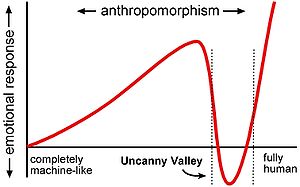
- Image via Wikipedia
Crossing the uncanny valley
ROBOT-MAKERS and the animators who design characters for films and video games face a paradox. People readily accept machines and cartoons that are simplifications or distortions of the human form. Simulacra that are intended to look like real people, though, are frequently perceived as creepy. In November 2004, for example, two films intended as light entertainment were released to very different receptions. “The Incredibles”, a cartoon in traditional style, was one of the most successful movies in history. “The Polar Express”, which used motion capture and computer graphics to produce an animation whose characters looked almost human, received a critical panning: one reviewer suggested its characters were so frightening the film should be subtitled “The Night of the Living Dead”.
The difference lay in that one crucial word: almost. Workers in the field refer to the perceptual crevasse which separates acceptable caricature from accurate representation as “the uncanny valley”—and the “The Polar Express” fell right into it. Mapping the uncanny valley, to avoid its perils, would be of great benefit to film-makers. It would also, as robots become smart and safe enough for use outside factories, help engineers to design plastic pals who are truly fun to be with.
Though several previous expeditions have been lost in the valley, there is no shortage of volunteers to have another go. The latest pair to harness up the metaphorical huskies are Chin-Chang Ho and Karl MacDorman of the Indiana University School of Informatics. They think they can find their way by following a new compass direction—the quality of eeriness.
The valley below
The idea of the uncanny valley was originally proposed by Masahiro Mori, a Japanese roboticist, in 1970. Though he had no hard data, his intuition was that increasing humanness in a robot was positive only up to a certain point. Dr Mori drew a graph (see chart) with “human-likeness” on the horizontal axis and a quality he called shinwakan (variously translated as “familiarity” and “comfort level”) on the vertical one. As an object or image looks and behaves more like a human, the viewer’s level of shinwakanincreases. Beyond a certain point, however, the not-quite-human object strikes people as creepy, and shinwakandrops. This is the uncanny valley. Only when the object becomes almost indistinguishable from a human does shinwakan increase again.









